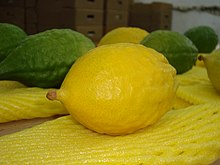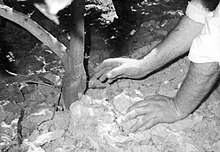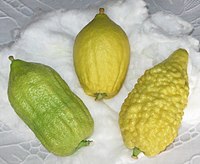Diamante citron
| Diamante Citron | |
|---|---|
 | |
| Species | C. medica |
| Cultivar | var. cedro di Calabria |
| Marketing names | Yanover esrog |
The Diamante citron (Citrus medica cv. diamante[1] − Italian: cedro di diamante, Hebrew: אתרוג קלבריה or גינובה) is a variety of citron named after the town of Diamante, located in the province of Cosenza, Calabria, on the south-western coast of Italy, which is its most known cultivation point. This is why this variety is sometimes called the "Calabria Esrog". "Esrog" is the Ashkenazi Hebrew name for citron.
diamante ('Cedro liscio'; possibly the same as 'Italian' and 'Sicilian')–of unknown origin but the leading cultivar in Italy and preferred by processors elsewhere; long-oval or ellipsoid, furrowed at base, broadly nippled at apex; peel yellow, smooth or faintly ribbed; very thick, fleshy; pulp crisp, non-juicy, acid; seedy. Tree small, spreading, thorny as 'Corsican'. Very similar is a cultivar called "Earle" in Cuba.
History[edit]
The Diamante citron was one of the most important varieties candied by the largest factories at Livorno, Italy; it was gathered from Liguria, Naples, Calabria & Sicily and then shipped to England and the United States.[2]
Association with Genoa[edit]
Many religious Jews call it Yanover Esrog (Genoa citron), because of a long association of the fruit with the trading port of Genoa in northern Italy, that exported it to other countries.
Genoa was known to supply citron for the Jews since the times of the Tosafists, along with surrounding municipalities Sanremo, Bordighera, and the rest of Liguria.[3] The city is located in the region of Liguria, which itself has a long history of citron cultivation,[4] thanks to the massive mountain chain (Apennines) which protects it from turbulent winds.[5]
Genoa has also a known history of banking, and they may have also traded the citron grown in the rest of the country, including from Corsica and Calabria, being a well established seaport as well. Therefore, the Calabrian citron is also considered to be of oldest Ashkenazic tradition for the Jewish ritual during the Feast of Tabernacles.[6]

Most adherent to the diamante variety of Calabria are Chabad Hasidim, whose late Rebbes were always in support of this traditional variety, even claiming by virtue of a legend that Moses himself obtained his esrog from this location.[7] Among the other Hasidic sects, it is most used by the Satmars.[8]
Kashrus supervision[edit]
The citron in Calabria was celebrated by poets like Byron and D'Annunzio, but is only saved from extinction thanks to the Jewish tradition.[9][full citation needed]
Because Calabria is at the southern point of Italy, and its climate most Mediterranean, it is the most suitable for the citron. Despite the milder climate, during the winter it is still too cold for the citron; this is why the farmers need to protect them with blue or green plastic covers. Most of the citron trees in the area are grafted onto foreign citrus rootstock, in order to save them from frost and disease. This practice renders their fruits non-kosher for the Sukkot ritual, and therefore in order for mashgichim to certify a citron as kosher, they must first carefully inspect the tree to confirm it was not grafted.
A Jewish delegation comes from Israel to Santa Maria del Cedro every year between July and August to choose the best fruit to be used in the holiday for the Jewish community. The selection of the best fruit is a virtual ritual. The mashgichim, each followed by a worker carrying a box and a pair of scissors, go to the citron farms at five in the morning. The mashgiach or machgicha proceeds slowly looking left and right. Then they stop and look at the base of the tree, right where the trunk comes up from the ground. A smooth trunk means the tree has not been grafted and the fruit can be picked. The mashgiach or mashgicha lies down on the ground to better examine the lower branches between the leaves.

Once a suitable fruit is found, the mashgiach or mashgicha shows it to the worker who cuts it off leaving a piece of the stalk. Then the mashgiach or mashgicha analyses the picked citron one more time and if they decide it is worthy they wrap it in oakum and puts it in the box. The farmer receives the agreed sum for each picked fruit. Then the boxes are sealed and sent to the Lamezia Terme International Airport, their final destination Tel Aviv.[10]
Although diamante is also grown in Puerto Rico, Sicily and Sardinia, their citrons are not used for the Jewish ritual, since no kashrut certification was present at transplantation. Seeds and cuttings of inspected trees were planted in the Israeli village of Kfar Chabad, with the hechsher certification by major kashrut organizations.
The methods for tree checking to verify if the tree is grafted or not were established by a board of rabbis in Israel by 1877 as described in Kuntres Pri Etz Hadar[11] which was published in Jerusalem a year after.
Other citron varieties[edit]
| Citron varieties |
|---|
 |
| Acidic-pulp varieties |
| Non-acidic varieties |
| Pulpless varieties |
| Citron hybrids |
| Related articles |
- Citron of Calabria
- Different Citron varieties used as Etrog, are the Greek Citron, the Balady Citron, Moroccan Citron and Yemenite Citron
- Citron varieties, or hybrids not used for the ritual, are the Fingered Citron and Florentine Citron
See also[edit]
References[edit]
Footnotes[edit]
- ^ Composition of the Leaf and Peel Oils of Citrus medica L. 'Diamante' from Crete
- ^ The Cultivated Oranges and Lemons
- ^ The Citrus Industry citation by Google Books
- The Citrus Industry online Archived 2007-08-08 at the Wayback Machine in name of Georges Gallesio
- Traité du citrus by Giorgio Gallesio p. 256 (in French)
- ^ Orange Insects
- ^ Flückiger, Friedrich August (1877). An Easter Holiday in Liguria. p. 21 – via Internet Archive.
liguria citrus wind.
- ^ Oekonomische Encyklopädie
- Traité du citrus by Giorgio Gallesio (in French)
- Manuale di arboricoltura by Giuseppe Antonio (in Italian)
- Enciclopedia di scienze politiche (in Italian)
- The Gardener's Monthly and Horticulturist
- Descrizione di Genova e del Genovesato (in Italian)
- Lettere sopra i buccheri (in Italian)
- Dell'idioma e della letteratura genovese (in Italian)
- ^ Why an Italian Etrog
- ^ "A Hasidic Pilgrimage to Saint Mary of the Etrog". Haaretz. Retrieved 2022-01-23.
- ^ Discovery Jewish Italy – academy article
- ^ Ansa Mediterraneo- Religion Rome Jewish Leaders Visit Cosenza Citron Farms
- ^ Kuntres Pri Etz Hadar
Notations[edit]
- Isaac, Erich. (1959). Influence of religion on the spread of citrus: The religious practices of the Jews helped effect the introduction of citrus to Mediterranean lands. Science, 129: 179-186.
- Article by Rabbi Tzinner about Yanove Etrog
- Etrog in Hebrew Wikipedia
External links[edit]
- Ha-Levanon 11 – no 7, Ha-Levanon 12 – no 4, page 2 gives a detailed list of cultivation areas and shipping system of ritual citron in Italy.
- A rabbi inspects trees for grafting signs
- The wanderings of plants and animals from their first home; By Victor Hehn, James Steven Stallybrass, digitized by Internet Archive
- The Citron that the Chabad Rabbeim used
- ChabadPedia about Calabria citron
- The diamante Variety described by The Purdue University
- The Citrus Variety Collection by the University of California
- Citrus Pages with pictures Archived 2015-08-16 at the Wayback Machine
- Chabad Website.
- The Mesoreh about the Calabrian Etrog
- Center for the Study of Jewry in Calabria and Sicily
- Essential Oils
- A study on glutamate oxaloacetate transaminase isozymes of citron cultivars
- A DNA Comparison study
- Postcard from Calabria
- Zitrus Freunde
